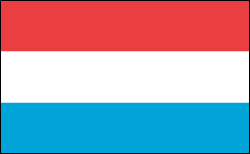LUXEMBOURG

Geography: Luxembourg is about half the size of Delaware. The Ardennes Mountains extend from Belgium into the northern section of Luxembourg. The rolling plateau of the fertile Bon Pays is in the south.
Government: Constitutional monarchy.
History: Luxembourg, once part of Charlemagne's empire, became an independent state in 963, when Siegfried, count of Ardennes, became sovereign of Lucilinburhuc (“Little Fortress”). In 1060, Conrad, a descendant of Siegfried, took the title count of Luxembourg. From the 15th to the 18th century, Spain, France, and Austria held the duchy in turn. The Congress of Vienna in 1815 made it a grand duchy and gave it to William I, king of the Netherlands. In 1839, the Treaty of London ceded the western part of Luxembourg to Belgium. The eastern part, continuing in personal union with the Netherlands and a member of the German Confederation, became autonomous in 1848 and a neutral territory by decision of the London Conference of 1867, governed by its grand duke. Germany occupied the duchy in World Wars I and II. Allied troops liberated the enclave in 1944.
Luxembourg joined NATO in 1949, the Benelux Economic Union (with Belgium and the Netherlands) in 1948, and the European Economic Community (later the EU) in 1957. In 1961, Prince Jean, son and heir of Grand Duchess Charlotte, was made head of state, acting for his mother. She abdicated in 1964, and Prince Jean became grand duke. Luxembourg's parliament approved the Maastricht Accord, paving the way for the economic unity of the EU in July 1992. Crown Prince Henri was sworn in as grand duke in Oct. 2000, replacing his father, Jean, who had been head of state for 26 years.
Government: Constitutional monarchy.
History: Luxembourg, once part of Charlemagne's empire, became an independent state in 963, when Siegfried, count of Ardennes, became sovereign of Lucilinburhuc (“Little Fortress”). In 1060, Conrad, a descendant of Siegfried, took the title count of Luxembourg. From the 15th to the 18th century, Spain, France, and Austria held the duchy in turn. The Congress of Vienna in 1815 made it a grand duchy and gave it to William I, king of the Netherlands. In 1839, the Treaty of London ceded the western part of Luxembourg to Belgium. The eastern part, continuing in personal union with the Netherlands and a member of the German Confederation, became autonomous in 1848 and a neutral territory by decision of the London Conference of 1867, governed by its grand duke. Germany occupied the duchy in World Wars I and II. Allied troops liberated the enclave in 1944.
Luxembourg joined NATO in 1949, the Benelux Economic Union (with Belgium and the Netherlands) in 1948, and the European Economic Community (later the EU) in 1957. In 1961, Prince Jean, son and heir of Grand Duchess Charlotte, was made head of state, acting for his mother. She abdicated in 1964, and Prince Jean became grand duke. Luxembourg's parliament approved the Maastricht Accord, paving the way for the economic unity of the EU in July 1992. Crown Prince Henri was sworn in as grand duke in Oct. 2000, replacing his father, Jean, who had been head of state for 26 years.

Map of
Luxembourg
Ruler: Grand Duke Henri
(2000)
Prime Minister:
Xavier Bettel (2013)
Total area: 998 sq mi (2,585 sq km)
Population (2014 est.): 520,672 (growth
rate: 1.12%); birth rate: 11.75/1000; infant mortality rate: 4.28/1000;
life expectancy: 80.01
Capital and largest city (2011 est.):
Luxembourg, 94,000
Monetary unit: Euro (formerly Luxembourg
franc)
National name: Grand-Duché de
Luxembourg
Languages:
Luxermbourgish (national) French, German (both
administrative)
Ethnicity/race:
Luxembourger 63.1%, Portuguese 13.3%, French 4.5%, Italian 4.3%, German 2.3%, other EU 7.3%, other 5.2% (2000 census)
Religions:
Roman Catholic 87%; Protestant, Jewish, Islamic
13% (2000)
National Holiday:
National Day, June 23
Literacy rate: 100% (2003 est.)
Economic summary: GDP/PPP (2013 est.):
$42.67 billion; per capita $77,900. Real growth rate: 0.5%.
Inflation: 1.8%. Unemployment: 4.9%. Arable land:
23.9%. Agriculture: wine, grapes, barley, oats, potatoes, wheat,
fruits; dairy products, livestock products. Labor force:
208,800 note: data exclude foreign workers; in addition to the
figure for domestic labor force, about 150,000 workers commute daily
from France, Belgium, and Germany (2013 est.) Industries: banking and financial
services, iron and steel, information technology, telecommunications,
cargo transportation, food processing, chemicals, metal products,
engineering, tires, glass, aluminum, tourism. Natural
resources: iron ore (no longer exploited), arable land.
Exports: $15.8 billion (2013 est.): machinery and
equipment, steel products, chemicals, rubber products, glass.
Imports: $23.12 billion (2013 est.): minerals, metals,
foodstuffs, quality consumer goods. Major trading partners:
Germany, France, Belgium, UK, Italy, Netherlands, China, U.S., Switzerland (2013).
Communications: Telephones: main lines
in use: 266,700 (2012); mobile cellular: 761,300 (2012). Broadcast media:
Luxembourg has a long tradition of operating radio and TV services to
pan-European audiences and is home to Europe's largest privately-owned
broadcast media group, the RTL group, which operates 46 TV stations and
29 radio stations in Europe; also home to Europe's largest satellite
operator, Societe Europeenne des Satellites (SES); domestically, the RTL
group operates TV and radio networks; other domestic private radio and
TV operators and French and German stations available; satellite and
cable TV services available (2008). Internet Service Providers
(ISPs): 250,900 (2012). Internet users: 424,500 (2009).
Transportation: Railways: total: 275 km
(2008). Roadways: total: 2,899 km; paved: 2,899 km (including
152 km of expressways) (2008). Waterways: 37 km;
Moselle. Ports and terminals: Mertert. Airports: 2
(2013).
International disputes:
none.
-------------------- o --------------------
No comments:
Post a Comment